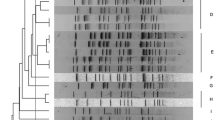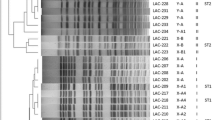Abstract
We conducted an epidemiological study concerning carbapenem-non-susceptible clinical isolates of Acinetobacter spp. in Japan by molecular procedures including carbapenemase gene identification and amplified ribosomal DNA restriction analysis. Among 598 clinically isolated Acinetobacter spp. in 2007, 27 (4.5%) were non-susceptible to carbapenems. Most carbapenem-non-susceptible Acinetobacter baumannii (13/14) belonged to clonal complex (CC) 92, harbored bla OXA-51-like genes, including novel bla OXA-206, downstream of ISAba1, and were recovered mainly from the Kanto region. Carbapenem-non-susceptible A. baumannii CC92 isolates were further divided by pulsed-field gel electrophoresis into two groups, one of which was characterized by the presence of bla OXA-23. One A. baumannii CC276 isolate carried bla IMP-1 and bla OXA-58. Almost all non-baumannii Acinetobacter isolates (12/13), including Acinetobacter pittii (formerly Acinetobacter genomic species 3) and Acinetobacter nosocomialis (formerly Acinetobacter genomic species 13TU), produced IMP-type metallo-β-lactamases, and were recovered from various regions in Japan. This is the first report describing the nationwide molecular epidemiology of carbapenem-non-susceptible Acinetobacter spp. with genomic species-level identification in Japan.

Similar content being viewed by others
References
Peleg AY, Seifert H, Paterson DL. Acinetobacter baumannii: emergence of a successful pathogen. Clin Microbiol Rev. 2008;21:538–82.
Turton JF, Ward ME, Woodford N, Kaufmann ME, Pike R, Livermore DM, et al. The role of ISAba1 in expression of OXA carbapenemase genes in Acinetobacter baumannii. FEMS Microbiol Lett. 2006;258:72–7.
Poirel L, Nordmann P. Genetic structures at the origin of acquisition and expression of the carbapenem-hydrolyzing oxacillinase gene bla OXA-58 in Acinetobacter baumannii. Antimicrob Agents Chemother. 2006;50:1442–8.
Dijkshoorn L, Aucken H, Gerner-Smidt P, Janssen P, Kaufmann ME, Garaizar J, et al. Comparison of outbreak and nonoutbreak Acinetobacter baumannii strains by genotypic and phenotypic methods. J Clin Microbiol. 1996;34:1519–25.
van Dessel H, Dijkshoorn L, van der Reijden T, Bakker N, Paauw A, van den Broek P, et al. Identification of a new geographically widespread multi resistant Acinetobacter baumannii clone from European hospitals. Res Microbiol. 2004;155:105–12.
Mugnier PD, Poirel L, Naas T, Nordmann P. Worldwide dissemination of the bla OXA-23 carbapenemase gene of Acinetobacter baumannii. Emerg Infect Dis. 2010;16:35–40.
Fu Y, Zhou J, Zhou H, Yang Q, Wei Z, Yu Y, et al. Wide dissemination of OXA-23-producing carbapenem-resistant Acinetobacter baumannii clonal complex 22 in multiple cities of China. J Antimicrob Chemother. 2010;65:644–50.
Park YK, Choi JY, Jung SI, Park KH, Lee H, Jung DS, et al. Two distinct clones of carbapenem-resistant Acinetobacter baumannii isolates from Korean hospitals. Diagn Microbiol Infect Dis. 2009;64:389–95.
Runnegar N, Sidjabat H, Goh HM, Nimmo GR, Schembri MA, Paterson DL. Molecular epidemiology of multidrug-resistant Acinetobacter baumannii in a single institution over a 10-year period. J Clin Microbiol. 2010;48:4051–6.
Ishii Y, Yamaguchi K. Evaluation of the susceptibility trends to meropenem in a nationwide collection of clinical isolates in Japan: a longitudinal analysis from 2002 to 2006. Diagn Microbiol Infect Dis. 2008;61:346–50.
Takahashi A, Yomoda S, Kobayashi I, Okubo T, Tsunoda M, Iyobe S. Detection of carbapenemase-producing Acinetobacter baumannii in a hospital. J Clin Microbiol. 2000;38:526–9.
Shibata N, Doi Y, Yamane K, Yagi T, Kurokawa H, Shibayama K, et al. PCR typing of genetic determinants for metallo-β-lactamases and integrases carried by gram-negative bacteria isolated in Japan, with focus on the class 3 integron. J Clin Microbiol. 2003;41:5407–13.
Yamaguchi K, Ohno A, Ishii Y, Tateda K, Iwata M, Kanda M, et al. In vitro susceptibilities to levofloxacin and various antibacterial agents of 12,919 clinical isolates obtained from 72 centers in 2007. Jpn J Antibiot. 2009;62:346–70.
Vaneechoutte M, Dijkshoorn L, Tjernberg I, Elaichouni A, de Vos P, Claeys G, et al. Identification of Acinetobacter genomic species by amplified ribosomal DNA restriction analysis. J Clin Microbiol. 1995;33:11–5.
Clinical and Laboratory Standards Institute. Methods for dilution antimicrobial susceptibility tests for bacteria that grow aerobically. 8th edn. Approved standard M107-A8. Wayne, PA: CLSI; 2009.
Arakawa Y, Shibata N, Shibayama K, Kurokawa H, Yagi T, Fujiwara H, et al. Convenient test for screening metallo-β-lactamase-producing gram-negative bacteria by using thiol compounds. J Clin Microbiol. 2000;38:40–3.
Woodford N, Ellington MJ, Coelho JM, Turton JF, Ward ME, Brown S, et al. Multiplex PCR for genes encoding prevalent OXA carbapenemases in Acinetobacter spp. Int J Antimicrob Agents. 2006;27:351–3.
Bartual SG, Seifert H, Hippler C, Luzon MA, Wisplinghoff H, Rodriguez-Valera F. Development of a multilocus sequence typing scheme for characterization of clinical isolates of Acinetobacter baumannii. J Clin Microbiol. 2005;43:4382–90.
Martinovich A, Edelstein M, Kozlov R. Multilocus sequence typing of Acinetobacter strains from Russia and Belarus that produce acquired OXA carbapenemases. In: Abstracts of the 49th interscience conference on antimicrobial agents and chemotherapy, San Francisco, 2009. Abstract C2-626. Washington, DC: American Society for Microbiology.
Feil EJ, Li BC, Aanensen DM, Hanage WP, Spratt BG. eBURST: inferring patterns of evolutionary descent among clusters of related bacterial genotypes from multilocus sequence typing data. J Bacteriol. 2004;186:1518–30.
Jeon BC, Jeong SH, Bae IK, Kwon SB, Lee K, Young D, et al. Investigation of a nosocomial outbreak of imipenem-resistant Acinetobacter baumannii producing the OXA-23 β-lactamase in Korea. J Clin Microbiol. 2005;43:2241–5.
Lin YC, Sheng WH, Chen YC, Chang SC, Hsia KC, Li SY. Differences in carbapenem resistance genes among Acinetobacter baumannii, Acinetobacter genospecies 3 and Acinetobacter genospecies 13TU in Taiwan. Int J Antimicrob Agents. 2010;35:439–43.
Xiao YH, Giske CG, Wei ZQ, Shen P, Heddini A, Li LJ. Epidemiology and characteristics of antimicrobial resistance in China. Drug Resist Updates. 2011;14:236–50.
Turner PJ. MYSTIC Europe 2007: activity of meropenem and other broad-spectrum agents against nosocomial isolates. Diagn Microbiol Infect Dis. 2009;63:217–22.
Lee JH, Choi CH, Kang HY, Lee JY, Kim J, Lee YC, et al. Differences in phenotypic and genotypic traits against antimicrobial agents between Acinetobacter baumannii and Acinetobacter genomic species 13TU. J Antimicrob Chemother. 2007;59:633–9.
Adams-Haduch JM, Onuoha EO, Bogdanovich T, Tian G, Marchall J, Urban CM, Spellberg BJ, et al. Molecular epidemiology of carbapenem-nonsusceptible Acinetobacter baumannii in the United States. J Clin Microbiol. 2011;49:3849–54.
Hamouda A, Evans BA, Towner KJ, Amyes SG. Characterization of epidemiologically unrelated Acinetobacter baumannii isolates from four continents by use of multilocus sequence typing, pulsed-field gel electrophoresis, and sequence-based typing of bla OXA-51-like genes. J Clin Microbiol. 2010;48:2476–83.
Pfeifer Y, Wilharm G, Zander E, Wichelhaus TA, Gottig S, Hunfeld KP, et al. Molecular characterization of bla NDM-1 in an Acinetobacter baumannii strain isolated in Germany in 2007. J Antimicrob Chemother. 2011;66:1998–2001.
Lee K, Kim MN, Choi TY, Cho SE, Lee S, Whang DH, et al. Wide dissemination of OXA-type carbapenemases in clinical Acinetobacter spp. isolates from South Korea. Int J Antimicrob Agents. 2009;33:520–4.
Kimura S, Alba J, Shiroto K, Sano R, Niki Y, Maesaki S, et al. Clonal diversity of metallo-β-lactamase-possessing Pseudomonas aeruginosa in geographically diverse regions of Japan. J Clin Microbiol. 2005;43:458–61.
Acknowledgments
The authors thank the technical staff and directors in the 72 hospitals as the Levofloxacin Surveillance Group. We express our deep appreciation to David M. Livermore, Yohei Doi, and Tse Hsien Koh for their critical comments and careful reviewing of the manuscript. This study was supported by the Ministry of Health, Labor, and Welfare of Japan (No. H21-Shinkou-Ippan-008 to K.Y.), and by a grant-in-aid for Scientific Research from the Ministry of Education, Culture, Sports, Science and Technology of Japan (No. 22591113 to Y.I.). This work was also supported by a grant from Daiichi Sankyo Co., Ltd. to collect Acinetobacter spp. isolates (to K.Y.).
Author information
Authors and Affiliations
Corresponding author
About this article
Cite this article
Kouyama, Y., Harada, S., Ishii, Y. et al. Molecular characterization of carbapenem-non-susceptible Acinetobacter spp. in Japan: predominance of multidrug-resistant Acinetobacter baumannii clonal complex 92 and IMP-type metallo-β-lactamase-producing non-baumannii Acinetobacter species. J Infect Chemother 18, 522–528 (2012). https://doi.org/10.1007/s10156-012-0374-y
Received:
Accepted:
Published:
Issue Date:
DOI: https://doi.org/10.1007/s10156-012-0374-y




